CPOpen: Your Gateway to Current Affairs
Stay updated with the latest trends and insights across various topics.
To the Moon: Why Dogecoin is More Than a Meme
Discover how Dogecoin evolved from a meme to a serious player in crypto. Uncover the potential and hype surrounding this viral currency!
The Rise of Dogecoin: How It Became a Leading Cryptocurrency
Dogecoin was initially created as a joke in December 2013 by software engineers Billy Markus and Jackson Palmer, but it quickly gained momentum beyond its meme origins. Unlike Bitcoin, which focuses on digital scarcity and is often viewed as a store of value, Dogecoin was designed to be an inflationary currency, with a large supply meant to encourage spending. This unique aspect attracted a community of fans, and it quickly grew into a vibrant online community that engaged users through social media platforms like Reddit and Twitter. For more on the early days of Dogecoin, check out this Investopedia article.
Fast forward to 2021, and Dogecoin surged to prominence, largely fueled by endorsements from influential figures, most notably Elon Musk, who frequently tweeted about the cryptocurrency. This increased visibility led to dramatic price spikes, making Dogecoin one of the top cryptocurrencies by market capitalization. The combination of a devoted community, social media hype, and celebrity endorsements helped solidify Dogecoin's reputation, making it a legitimate player in the world of digital currencies. To explore more about its meteoric rise, visit this Forbes article.

Understanding Dogecoin's Unique Community and Cultural Impact
Dogecoin has evolved into more than just a cryptocurrency; it boasts a vibrant community that is distinguished by its humor, creativity, and inclusivity. Initially created as a joke in 2013, Dogecoin gained popularity for its light-hearted meme culture. The Dogecoin community actively engages on platforms like Reddit and Twitter, sharing memes, hosting giveaways, and supporting charitable initiatives. This sense of belonging has attracted individuals from diverse backgrounds, fostering a collaborative atmosphere that encourages participation and innovation.
As a result of this unique cultural engagement, Dogecoin has found itself at the forefront of various philanthropic efforts. The community's commitment to social causes was highlighted when they raised funds to sponsor the Jamaican bobsled team in the 2014 Winter Olympics, showcasing their willingness to support others through the power of their currency. Furthermore, the Dogecoin Foundation continues to promote charitable initiatives, reinforcing the idea that cryptocurrency can be a force for good. Overall, the cultural impact of Dogecoin extends beyond finance, transforming it into a symbol of community spirit and social connection in the digital age.
Is Dogecoin Here to Stay? Analyzing Its Future Potential
Dogecoin, initially created as a meme cryptocurrency in 2013, has evolved significantly since its inception. It gained mainstream attention in recent years, partly due to endorsements from high-profile figures like Elon Musk. As the digital currency landscape continues to grow, many investors are left questioning: Is Dogecoin here to stay? The answer lies in several factors, including its community support, mainstream adoption, and technological advancements. According to Forbes, the strong and passionate community behind Dogecoin is one of its greatest assets, lending the cryptocurrency a sense of permanence that lesser-known coins may lack.
Furthermore, the potential for Dogecoin to be integrated into everyday financial systems is increasing. With partnerships and collaborations emerging, such as with UK charities and various payment platforms, the use cases for Dogecoin are expanding. This kind of adoption is essential for its long-term viability in the market. As stated in CoinTelegraph, for Dogecoin to cement its place in the crypto space, it needs to evolve beyond its meme origins, becoming a serious contender in the financial world.